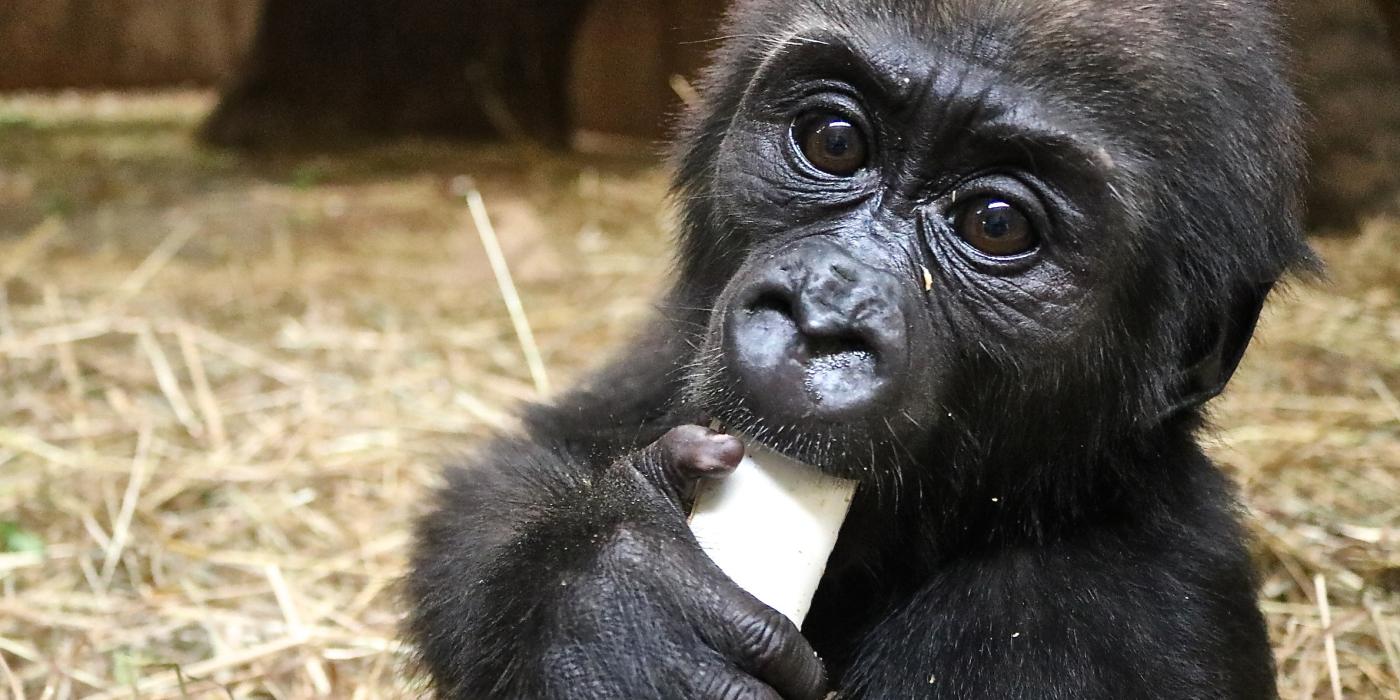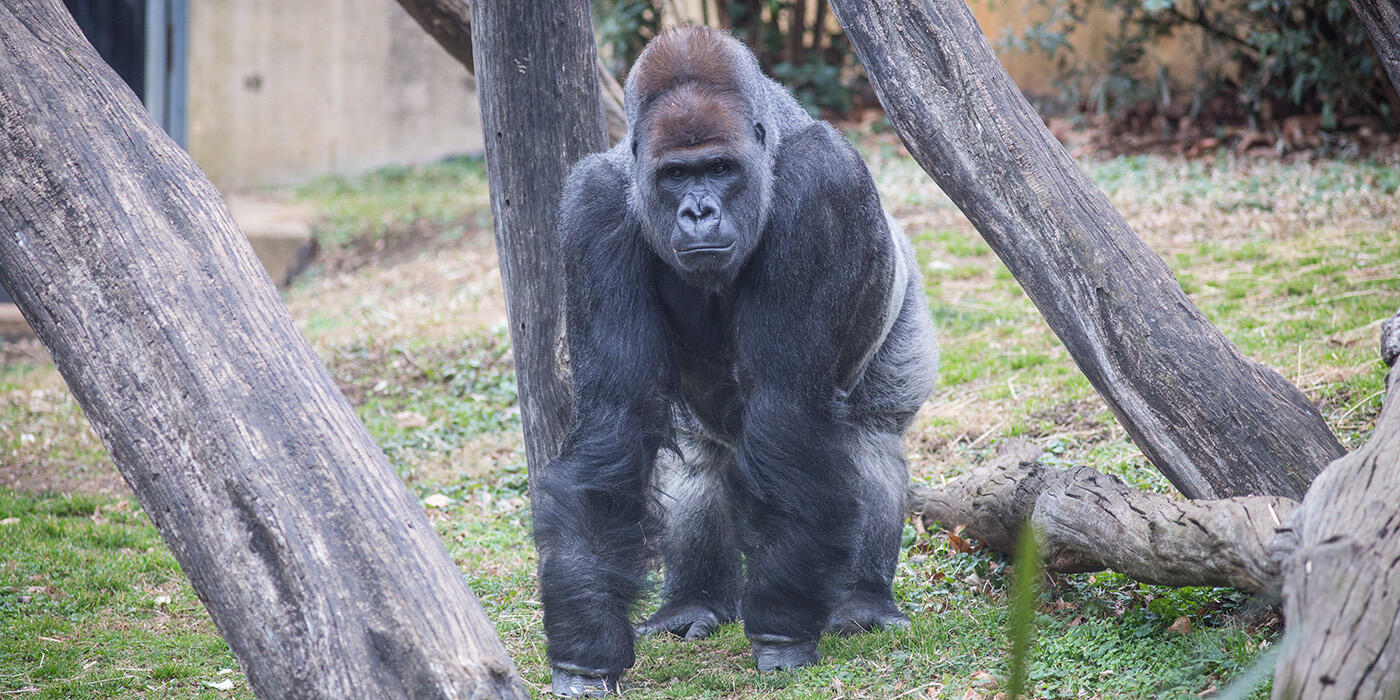#GorillaStory: Moke and Baraka

This update was written by primate keeper Melba Brown.
Regular readers of our weekly #GorillaStory updates will recognize why this week’s entry is a special one. Ever since our western lowland gorilla infant Moke was born April 15, my updates have mostly centered around his relationships with his mother, Calaya, our other adult female, Mandara and our sub-adult female, Kibibi.
During the first several months of his son’s life, Baraka largely observed Moke from a distance. As Moke grew and gained his footing, Calaya gave Baraka some leeway, allowing him to gently touch Moke’s head or briefly hold his hand. Now, at 5-and-a-half months old, Moke is able to interact more frequently with his dad, although these encounters always occur under Calaya’s supervision.
Earlier this week, I was interacting with Moke at the mesh when he began climbing. Suddenly, Baraka walked up to Moke. He vocalized softly, then touched his mouth to Moke’s mouth. This heartwarming encounter lasted only a few seconds, but it is indicative of the bond that is forming between these two.
On another occasion, I observed Baraka teaching Moke. As one of Baraka’s trainers, I work closely with him during husbandry training sessions. He knows these tasks—like presenting body parts on cue—very well, and he enthusiastically participates. Whenever he does the correct behavior, he receives positive reinforcement—grapes and verbal praise—as a reward. These sessions are fun enrichment for the both of us!
During one training session this week, Moke walked over to Baraka and made physical contact with his dad. To my surprise, Baraka moved his massive hand toward Moke and gave him a gentle nudge. Even though it was a slight movement, Moke lost his footing and fell on the hay. He quickly righted himself and once again touched his dad. Again, Baraka nudged Moke away. This time, Moke got the message. This was the first time I had seen Baraka interact with Moke this way. His direction was gentle, yet firm.
Aside from grapes, another popular diet item with our great apes is browse—fresh tree trimmings. The gorillas receive fresh browse every day and are quick to snap it up and devour it. Offerings include bamboo, Bradford pear and banana leaves, among others. Depending on the type of browse, the gorillas will eat just the leaves, or they will eat the leaves and the bark. Moke is able to tear pieces of a leaf with his teeth.
Browse and alfalfa hay are a nice and filling supplement to the gorillas’ diets. Adult male gorillas can eat upwards of 45 pounds of food a day; adult females eat a bit less than this. Visitors who come to the Great Ape House in the morning may see the troop eating their main diet as a group. Forage feedings give the troop an opportunity to eat together without much competition, which helps maintain strong social bonds.
During the afternoon, keepers feed the gorillas individually. Our Department of Nutrition Sciences delivers food across the Zoo daily, and they prepare individual diet bins for the apes. Each gorilla receives his or her own diet bin every day; that way, we ensure that all get a sufficient ration. These individual feedings give keepers a way to ascertain whether a gorilla’s appetite is normal or otherwise. If someone rejects his or her food, it is a sure sign something is amiss. Back in summer 2017, one of the first indications that Calaya was pregnant was that she left her favorite food—biscuits—behind during a feeding. Sure enough, it was due to a short bout of morning sickness!
Creating an environment where the gorillas can forage sometimes involves putting food into an enrichment puzzle feeder. These clever toys require the apes to use their natural abilities—and brain power—to extract the food within.
One of the group’s favorite enrichment items is a PVC tube containing peanut butter and sunflower seeds. I gave this to the group one afternoon, and Calaya swiftly gathered a stick and started working on getting the treats out. Moke tried his best to access the tube. At this moment, I witnessed Calaya intensify her disciplinary action towards Moke. She emitted a low-key ‘bark,’ gave him a nudge and put her mouth on his arm to deter his efforts.
After several attempts to reach the treat, Moke looked elsewhere for something to eat. I gave him some pieces of fruit to nosh on, which kept him occupied. When mom was finished with the PVC feeder, she put it down. At that point, Moke took it and put his mouth on the ends. Some remnant smudges were visible in the tube, and Moke was able to get a taste of the treat. Although Moke’s palate of new foods is expanding, he continues to nurse and receives the majority of his nutrition from Calaya’s milk.
As I have touched on in an earlier update, both gorillas and orangutans receive fabric that they use as part of their nesting materials. From time to time, some of them don the blankets and can look quite sporty! Kojo, in particular, strolls around his enclosure draped in fleece or cotton sheets often. He is doing well since his brother, Kwame, moved to Woodland Park Zoo. In fact, he is strutting as though he is the only silverback in town! Primate keepers have noted that Baraka seems calmer now that he only has one silverback next door to consider.
I would like to take a moment to express my sincerest gratitude to all of the readers who follow our #GorillaStory updates. I see our gorillas, especially Moke, as the epitome of animal ambassadors for their species. It is wonderful to be able to share their stories not only with people who visit the Smithsonian’s National Zoo physically, but also with those who visit virtually through social media and our e-newsletters. Your thoughtful comments and desire to learn more inspire me to share my knowledge and enthusiasm for the amazing animals in our care!
I feel honored to write this blog and thank you for sharing our troop’s story with your families, friends and loved ones. My hope is that you consider not only Moke and his troop, but also gorillas in the wild. All four subspecies—western lowland gorillas, mountain gorillas, Grauer’s gorillas and cross river gorillas—are critically endangered and face tremendous pressures that impact their survival. In future updates, I will share how all of us, through individual and collective actions, can help conserve this wonderful species.
Several readers expressed interest in volunteering. Positions with our Friends of the National Zoo (FONZ) volunteer program become available from time to time. I encourage you to check out this page, which has lots of great information about the program and current ways you can help.
Planning to visit Moke? Winter hours begin Oct. 1, and the Great Ape House will be open from 9 a.m. to 4:30 p.m. Don’t miss the gorilla keeper chat! Check the Daily Programs page for the full winter schedule of animal encounters.
Related Species:



